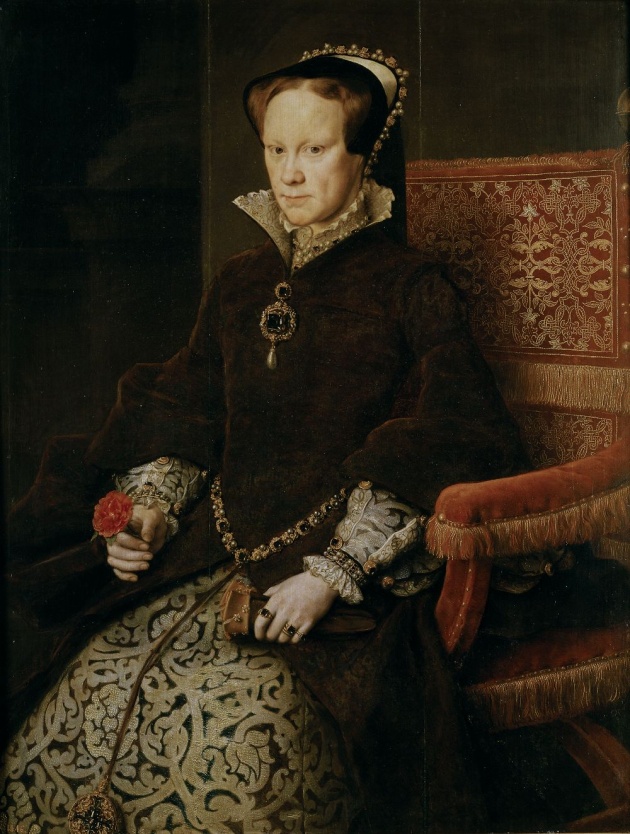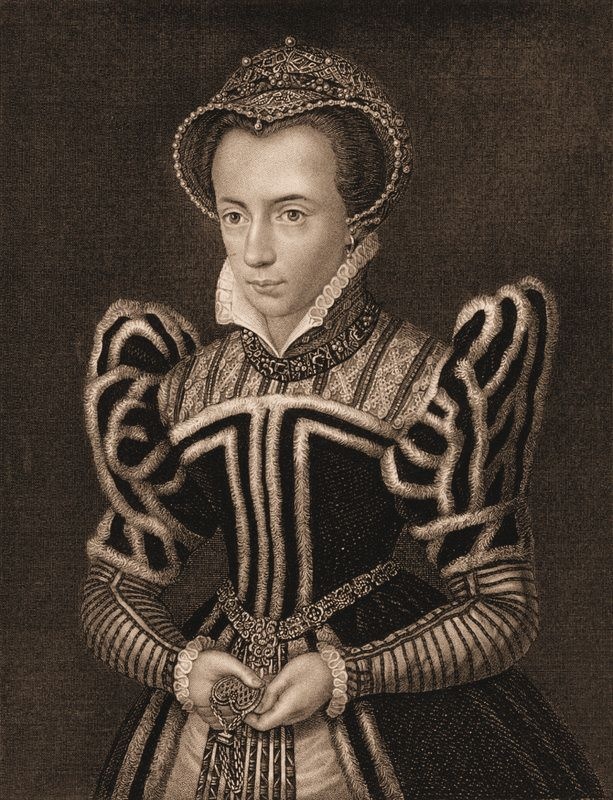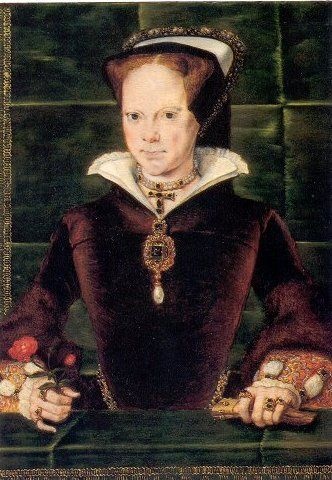Bloody Mary was a Catholic bigot, a half-Spanish tyrant who burned nearly 300 Protestant men, women and children in one of the most ferocious periods of persecution in Reformation Europe. At least that’s how subsequent (Protestant) writers painted her. John Foxe’s classic martyrology, Actes and Monuments (popularly known as the Book of Martyrs), first published in 1563, graphically depicted “the horrible and bloudy time of Queene Mary” and dominated accounts of Mary’s reign for nearly 500 years.
In his First Blast of the Trumpet Against the Monstrous Regiment of Women, written on the eve of Mary’s death, John Knox condemned Mary both as a woman ruler and a Catholic: she was a “horrible monster Jezebel” who “compelled [Englishmen] to bow their necks under the yoke of Satan”. Traditionally viewed through the prism of her religion, Mary’s fiveyear reign has been described as disastrous, unimaginative and ineffective, with no positive achievements.
Yet Mary was England’s first acknowledged queen regnant: the first woman to wear the crown of England. It was a situation that her father, Henry VIII, had gone to great and infamous lengths to avert. But Mary more than met the challenge. In unprecedented circumstances she proved courageous and politically accomplished. Her reign redefined the contours of the English monarchy and proved that queens could rule as kings.
For much of her life Mary had struggled to defend her right to the throne – and even to preserve her life. After the breakdown of the marriage between her mother, Catherine of Aragon, and Henry VIII she was demoted from royal princess to bastard. She was, for a time, written out of the succession by her father and, though reinstated by the 1544 Third Act of Succession and by Henry’s will, she remained illegitimate. When her nine-year-old brother Edward VI inherited the throne in 1547 and confronted Mary’s Catholicism, she declared that she would rather “lay her head on a block” than forsake her faith. Her supporters urged her to flee abroad, but Mary remained in England, determined to defend her claim to the crown.
BATTLE FOR THE CROWN:
Following her brother’s death in July 1553, Mary – against all odds – won the throne in an extraordinary coup d’état.
Edward had written Mary out of the succession and instead named the Protestant Lady Jane Grey as heir to the throne. Before the king’s death was made public, John Dudley, the Duke of Northumberland, had secured control of the Tower and had the royal artillery and coffers at his disposal. With London apparently secure, Lady Jane was proclaimed queen. When Mary received a tip-off that Edward’s death was imminent and Northumberland planned to capture her, she fled across East Anglia. One of her supporters described this as an act of “Herculean rather than of womanly daring”. At Framlingham Castle in Suffolk, Mary raised her standard and rallied the local gentry and commons to her cause. On 19 July she was proclaimed queen, and her accession was greeted joyously.
The scale of her achievement is often overlooked. Mary had led the only successful revolt against central government in 16thcentury England. She had eluded capture, mobilised a counter-coup and, in the moment of crisis, proved courageous, decisive and politically adept. By playing down her Catholicism and proclaiming her legitimacy, Mary secured both Catholic and Protestant support. She also ensured that the crown continued along the legal line of Tudor succession, in doing so, defending Elizabeth’s position as her heir (though this wasn’t made official until the final weeks of her life).
Having secured the throne, Mary then had to establish herself as a female monarch. It was an unprecedented position in a deeply patriarchal society – indeed, many questioned whether a woman could wear the crown. The monarch was understood to be God’s representative on Earth, a figure of defence and justice – a role premised on military might. The language, image and expectations of English monarchy and royal majesty were unequivocally male, and the rights of a queen regnant were a matter of great uncertainty.
Mary’s accession had changed the rules of the game, and the nature of this new feminised politics was yet to be defined, yet in many respects Mary proved more than equal to the task. Decisions over the details of the practice and power of a queen regnant became precedents for the future. In April 1554 Mary’s parliament passed the Act for Regal Power, which enshrined in law that queens held power as “fully, wholly and absolutely” as their male predecessors, thereby establishing the gender-free authority of the crown.
uthority of the crown. Mary’s coronation saw her accepting the full regalia of a male monarch and assuming the sacral role that had hitherto been confined to kings. Previously, it had been precisely the exercise of this semi-priestly power, derived from the coronation, that – it was argued – precluded women from acceding to the throne. By continuing practices undertaken by previous kings – providing the healing touch for the ‘king’s evil’ (scrofula) and blessing rings believed to cure cramp and epilepsy – Mary showed that the office of crowned monarch was not limited by gender.
Mary had stated a preference for remaining single but accepted the need to marry to fulfil her public duty to her faith and her kingdom. Everyone agreed on the need for a husband who could guide her in ruling, and produce a male heir, thereby securing the succession. Though it has traditionally been argued that Mary’s marriage to Philip of Spain was unpopular, an alliance with Habsburg Spain was politically expedient. Certainly, the marriage treaty was as “favourable as possible for the interest and security and even the grandeur of England”, with Mary’s legal rights as queen preserved and Spanish influence kept to a minimum.
For some, though, this was not enough. In January 1554 Mary faced a Protestant rebellion led by Thomas Wyatt that aimed to prevent the match, but once again the queen rose to the occasion. Despite the urging of her councillors she refused to leave London; then, in a remarkable speech at the Guildhall, she attacked Wyatt as a wicked traitor, defended her religion and choice of husband, and called on Londoners to stand firm in support. Mary stressed her defiance, courage and commitment not by claiming to have the qualities of a man but, rather, to have these qualities as a woman. Mary’s rousing rhetoric so mobilised the people of London that when Thomas Wyatt approached the Tower he found Ludgate barred against him. The rebels were compelled to lay down their arms and sue for mercy. Mary was manifestly an effective public speaker well before her sister Elizabeth garnered the plaudits.
Mary’s reputation has been almost entirely defined by religion and summed up by the infamous epithet ‘Bloody Mary’. Elizabethan Protestants, who were the first to write the history of Mary’s reign, characterised the regime as violently repressive, spiritually moribund and resoundingly unsuccessful. Yet in many ways Mary’s programme to convert hearts and minds to Roman Catholicism was innovative and energetic. Led by Cardinal Reginald Pole, the programme of recatholicisation encouraged preaching and used the printing press to produce homilies and catechisms, and to foster a parochial revival of Catholicism.
Even the burnings – the accepted punishment for heresy at the time – were, it has been argued, broadly effective. Laymen were fully and enthusiastically involved in the work of detecting heretics, and by 1558 the numbers being burned were falling. The Marian church was proving successful in its mission – but then Mary died prematurely, after just five years of rule and with no Catholic heir.
TO BE CONTINUED...
QUEEN MARY I (The Bloody Mary) (P1)
Posted on at



